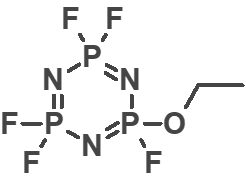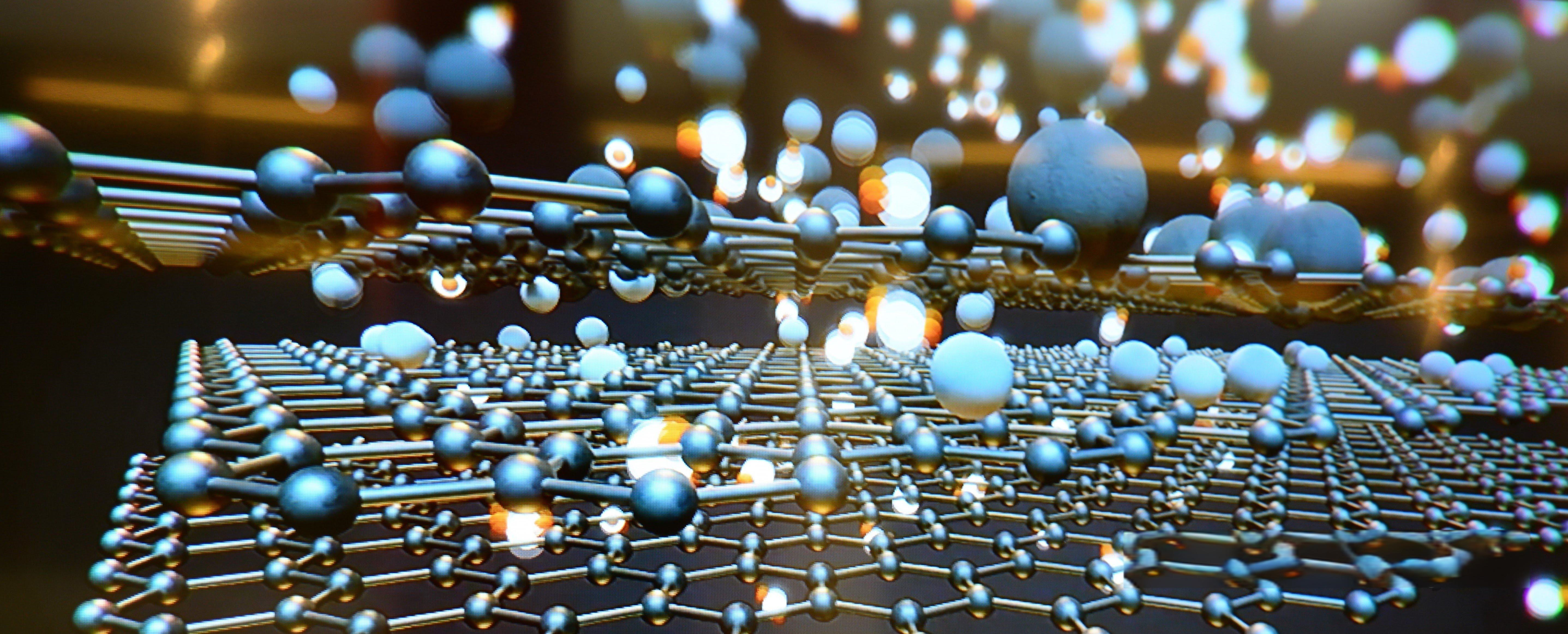Advanced Fire Protection: Flame Retardant Ethoxy(Pentafluoro) Cyclotriphosphazene (CAS No. 33027-66-6)
Flame retardants play a critical role in bolstering the safety of materials used across diverse industries such as construction, electronics, and textiles, effectively mitigating the risk of fire incidents. Ethoxy(Pentafluoro) Cyclotriphosphazene (CAS No. 33027-66-6), a cutting-edge flame retardant developed by UniVOOK Chemical, excels in fulfilling this pivotal function. Chemically classified as a cyclotriphosphonitrile compound, EPCP is distinguished by its incorporation of phosphorus (P) and fluorine (F) elements, synergistically enhancing its flame retardant properties with exceptional efficiency. This innovation not only advances safety standards but also fosters the creation of more resilient, fire-resistant materials across critical industrial applications.

Chemical Structure and Properties
Molecular Structure and Chemical Formula
Ethoxy(Pentafluoro) Cyclotriphosphazene, known by its CAS No. 33027-66-6, is a key component in enhancing the safety of various materials through its flame-retardant properties. Produced by UniVOOK Chemical, this compound is employed notably as an electrolyte flame retardant additive in lithium-ion batteries among other types. Its unique ability to form an effective Solid Electrolyte Interface (SEI) film on electrode interfaces drastically enhances the compatibility between the electrolyte and active elements, ensuring superior electrochemical performance. This includes robust oxidation resistance and notable improvements in high voltage cycle performance, thereby increasing battery safety significantly.
Key Physical and Chemical Properties
The physical and chemical properties of Ethoxy(Pentafluoro) Cyclotriphosphazene contribute to its effectiveness as a flame retardant. While specific details like its melting point, boiling point, and solubility are tailored to optimize performance in diverse applications, these characteristics generally underscore its stability and functionality in high-demand environments such as electronic materials production and textile manufacturing. Additionally, it serves as an intermediate in organic synthesis, expanding its utility across various chemical processes.
Comparison with Traditional Flame Retardants
Comparatively, Ethoxy(Pentafluoro) Cyclotriphosphazene offers enhanced effectiveness and reduced environmental impact over many traditional flame retardants. Its chemical stability means less degradation into potentially harmful byproducts, aligning with contemporary environmental standards and safety regulations. This not only reduces the ecological footprint but also provides industries with a more sustainable option for fire safety.
Mechanism of Action
How Ethoxy(Pentafluoro) Cyclotriphosphazene Works as a Flame Retardant
Ethoxy(Pentafluoro) Cyclotriphosphazene acts primarily by hindering the thermal degradation process that fuels fires. Upon exposure to heat, it decomposes to release phosphorus-containing compounds, which help in forming a char layer on the material’s surface. This char acts as a barrier, slowing the release of volatile gases that propagate flames, thereby enhancing the material’s resistance to burning.
Interaction with Materials Under Fire Conditions
When incorporated into polymer matrices or fabrics, Ethoxy(Pentafluoro) Cyclotriphosphazene significantly alters the fire response of these materials. It integrates into the host material’s structure, contributing to a more robust char formation during combustion. This interaction not only impedes the spread of flames but also reduces the intensity of the heat released, providing crucial extra seconds for fire response and evacuation procedures.
Thermal Degradation Pathway and Impact on Fire Behavior
The thermal degradation pathway of Ethoxy(Pentafluoro) Cyclotriphosphazene is characterized by its ability to elevate the decomposition temperature of the host material. This alteration in the thermal degradation process effectively delays the onset of significant combustion, thereby minimizing the material’s contribution to fire growth and spread. This mechanism is critical in high-risk environments where fire safety is paramount, offering a higher margin of safety and reducing potential damage and loss.

Applications
Versatile Industry Applications
Ethoxy(Pentafluoro) Cyclotriphosphazene finds widespread use across diverse industries owing to its exceptional flame-retardant capabilities. In textiles, it is integrated into fabrics to mitigate flammability risks and elevate safety standards. Within electronics, this compound is crucial for preventing fire incidents stemming from electrical malfunctions. Moreover, the construction sector relies on it to meet stringent fire safety regulations, thereby fostering safer residential and commercial environments.
Advantages Over Traditional Flame Retardants
Ethoxy(Pentafluoro) Cyclotriphosphazene surpasses conventional flame retardants in several key aspects. It demonstrates superior efficiency in suppressing flames, boasts enhanced durability, and offers better cost-effectiveness. Its robust chemical stability ensures prolonged efficacy under harsh conditions, reducing the frequency of reapplications and providing sustained safety solutions at a reduced cost over time.
Successful Applications
In the electronics industry, Ethoxy(Pentafluoro) Cyclotriphosphazene has been instrumental in enhancing fire safety. Case studies within major manufacturing facilities have highlighted significant reductions in burn rates and smoke production when this compound is incorporated into wiring and electronic components. Such outcomes underscore its effectiveness in real-world fire scenarios, bolstering its reputation as a reliable flame retardant solution.
Environmental and Safety Considerations
Environmental Impact Evaluation
Ethoxy(Pentafluoro) Cyclotriphosphazene exhibits a favorable environmental profile compared to older-generation flame retardants. It is designed to be less persistent in the environment, thereby minimizing long-term ecological impact. Biodegradability studies indicate that this compound breaks down more readily than traditional alternatives, mitigating concerns associated with bioaccumulation and environmental persistence.
Toxicological Profile and Human Health Implications
Extensive studies have validated the compound’s low toxicity profile, ensuring minimal risk to human health. Unlike certain conventional flame retardants implicated in endocrine disruption or carcinogenicity, Ethoxy(Pentafluoro) Cyclotriphosphazene has demonstrated safety in both acute and chronic exposure scenarios. Ongoing research and vigilance remain essential to continuously monitor and uphold safety standards across its diverse applications.
Future Trends and Challenges
Evolving Trends in Flame Retardant Technology
The future of flame retardant technology is moving towards environmentally sustainable and health-conscious solutions. Innovations are increasingly focused on developing flame retardants that are recyclable, less toxic, and possess multifunctional properties. Ethoxy(Pentafluoro) Cyclotriphosphazene exemplifies this shift, paving the way for future advancements that prioritize both efficacy and environmental responsibility.
Research and Development Directions
Ongoing research endeavors are directed at refining Ethoxy(Pentafluoro) Cyclotriphosphazene formulations to enhance its multifunctionality. This includes integrating additional properties such as antimicrobial capabilities or improved mechanical strength alongside its flame retardant attributes. Such developments aim to broaden its applicability across diverse industries while further enhancing safety and performance standards.
Adoption and Commercialization Challenges
Despite its benefits, widespread adoption of advanced flame retardants like Ethoxy(Pentafluoro) Cyclotriphosphazene faces several challenges. These include the initial costs associated with transitioning from traditional materials, resistance from established safety protocols, and the need for rigorous certification and testing to gain market acceptance. Overcoming these hurdles is pivotal for expanding commercialization and realizing the full safety potential of innovative flame retardant technologies.
Final Thoughts
Ethoxy(Pentafluoro) Cyclotriphosphazene marks a significant leap forward in flame retardant technology, excelling in efficacy and adaptability across diverse sectors such as textiles, electronics, and construction. With superior flame suppression abilities, extended durability, and cost-effectiveness, it outshines conventional options. Its robust environmental and safety credentials, confirmed through rigorous testing and compliance with global standards, underscore its reliability. As industries increasingly prioritize sustainability and safety, Ethoxy(Pentafluoro) Cyclotriphosphazene exemplifies the potential of innovative chemical solutions that uphold stringent environmental and health criteria. While challenges in adoption and market penetration persist, ongoing research promises to refine its capabilities, ensuring its continued leadership in advancing fire safety technology.
Access Our Product Catalog and More to Discover High-Performance Chemicals Tailored to Your Business Needs





